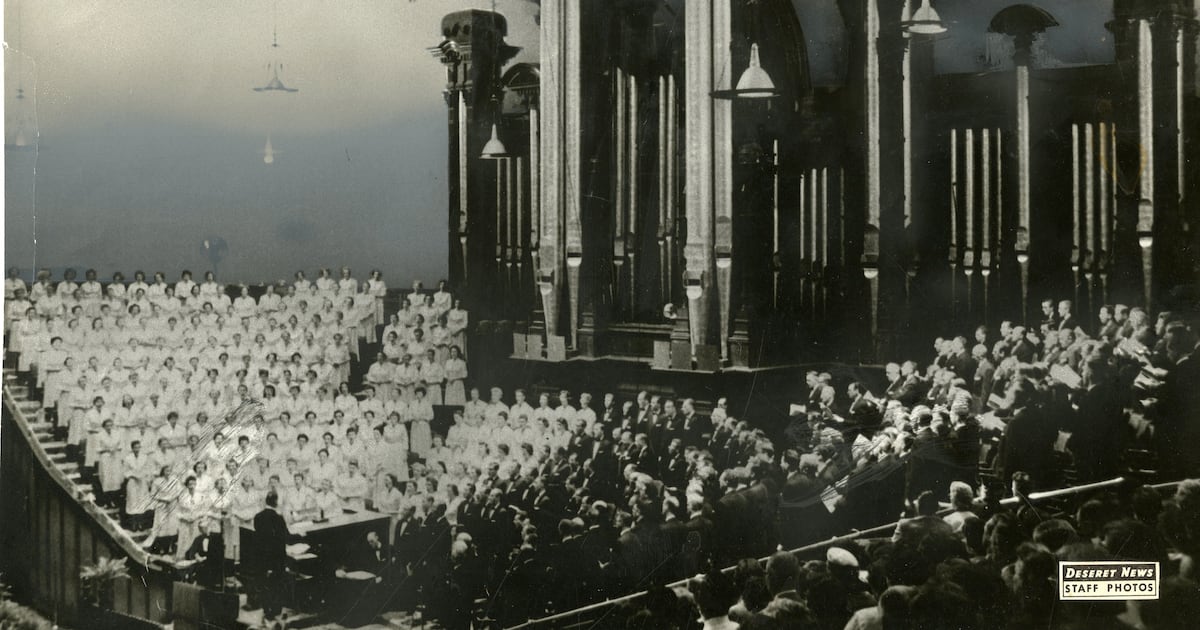The first “Music & the Spoken Word” broadcast with The Tabernacle Choir at Temple Square was on Monday, July 15, 1929, and scheduled for 3 p.m.
A single microphone for the choir and announcer was attached to the ceiling, with a long cable connecting it to KSL’s radio controller, located a city block away. Nineteen-year-old Ted Kimball, son of organist Edward P. Kimball, climbed a 15-foot-tall stepladder and announced each song that was sung by the choir.
A short article the following day in the Deseret News noted the success of the first broadcast, calling it “highly satisfactory.” The broadcast was transmitted to WJZ in New York over the telephone system and then went to more than 30 stations, including KSL.
“In the opinion of the National Broadcasting Co. officials, the weekly broadcasts of the Tabernacle Choir and organ will prove a most popular program,” concludes the article.
Ninety-six years later, Sunday, July 13, 2025, marked the 5,000th week of broadcasting for the 360-voice Tabernacle Choir’s weekly 30-minute “Music & the Spoken Word” broadcast.
Here’s more about the historical broadcasts from the Church News archives.

Milestone broadcasts
First broadcast: July 15, 1929
1,000th broadcast: Oct. 17, 1948
2,000th broadcast: Dec. 17, 1967
3,000th broadcast: Feb. 15, 1987
4,000th broadcast: April 30, 2006
5,000th broadcast: July 13, 2025
First broadcast
The program on Monday, July 15, 1929, was under the direction of director Anthony C. Lund with Edward P. Kimball at the organ. The broadcast opened — as it still does — with “Gently Raise the Sacred Strain.”
- Chorale from the “Meistersinger” by Richard Wagner
- “Sonata in B-flat Minor,” first movement, by Boslip (organ solo)
- “The Morning Breaks,” by George Careless
- “An Old Melody,” arranged by Edward Kimball (organ solo)
- The finale from “Elijah,” by Felix Mendelssohn
- “The Pilgrim’s Chorus” from “Tannhäuser,” by Richard Wagner (organ solo)
As the first broadcast concluded, Lund said: “Wow! I’m glad that’s over with.” Then glancing up at the microphone, he added, “Gosh, I hope that thing’s off.”
A large red curtain was hung from floor to ceiling in the Tabernacle in the first rows of the benches — and those benches covered with carpet — to help with the sound quality for a single microphone.

Tuning in …
• The first broadcast on July 15, 1929, reached more than 30 stations.
• “Music & the Spoken Word” moved to a Sunday morning spot in September 1932 when KSL switched networks.
• The 1,000th broadcast on Oct. 17, 1948, reached an estimated radio audience of 10 million listeners.
• By the 2,000th broadcast on Dec. 17, 1967, “Music & the Spoken Word” was aired on 300 U.S. radio stations and 128 television outlets; broadcast through television, AM/FM, short-wave radio and U.S. Armed Forces radio; and available in Canada, South and Central America and more of Europe, Australia and New Zealand — reaching an estimated two-thirds of the world.
• By the 5,000th broadcast, 6 million people in 50 countries around the world were tuning in via radio, television or online.

Singing in 2,000 broadcasts
At the 2,000th broadcast on Dec. 17, 1967, there were five choir members who had participated in the first broadcast in 1929. They were:
- Cornelius G. Van Os
- Deinna Van Os
- Jessie Evans Smith
- Kenneth Rogerson
- Margaret S. Hewlett
The Tabernacle Choir at Temple Square’s conductors

- John Parry 1849-1854
- Stephen Goddard 1854-1856
- James Smithies 1856-1862
- Charles John Thomas 1862-1865
- Robert Sands 1865-1869
- George Careless 1869-1880
- Thomas Griggs 1880
- Ebenezer Beesley 1880-1889
- Evan Stephens 1889-1916
- Anthony C. Lund 1916-1935
- J. Spencer Cornwall 1935-1957
- Richard P. Condie 1957-1974
- Jay E. Welch 1974
- Jerold Ottley 1974-1999
- Craig Jessop 1999-2008
- Mack Wilberg 2008-present
‘Music & the Spoken Word’ presenters
Nineteen-year-old Ted Kimball climbed the 15-foot ladder to read the names of the musical numbers each week until he was called on a mission to France. Other KSL staff members filled that announcer position, including Earl J. Glade, the station manager who “convinced the National Broadcasting Co. that the choir would be a good network feature,” and Roscoe Glover, according to the Church News’ coverage of the 2,000th broadcast in the Dec. 16, 1967, edition.

A young returned missionary named Richard L. Evans began in June 1930. The reading of the musical titles became “a meaningful reading of the message of the song.” Over time, this was expanded to the 2½- to three-minute “Spoken Word,” according to the archives. He continued these “sermonettes” after he became a member of the Quorum of the Twelve Apostles.
- Elder Richard L. Evans 1930-1971
- J. Spencer Kinard 1971-1990
- Lloyd D. Newell 1990-2024
- Derrick Porter 2024-present
